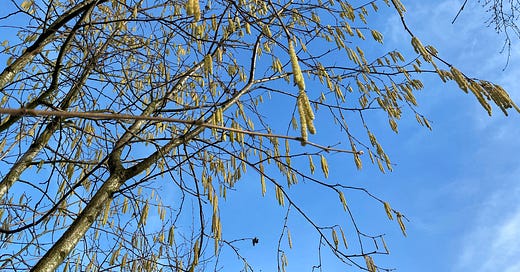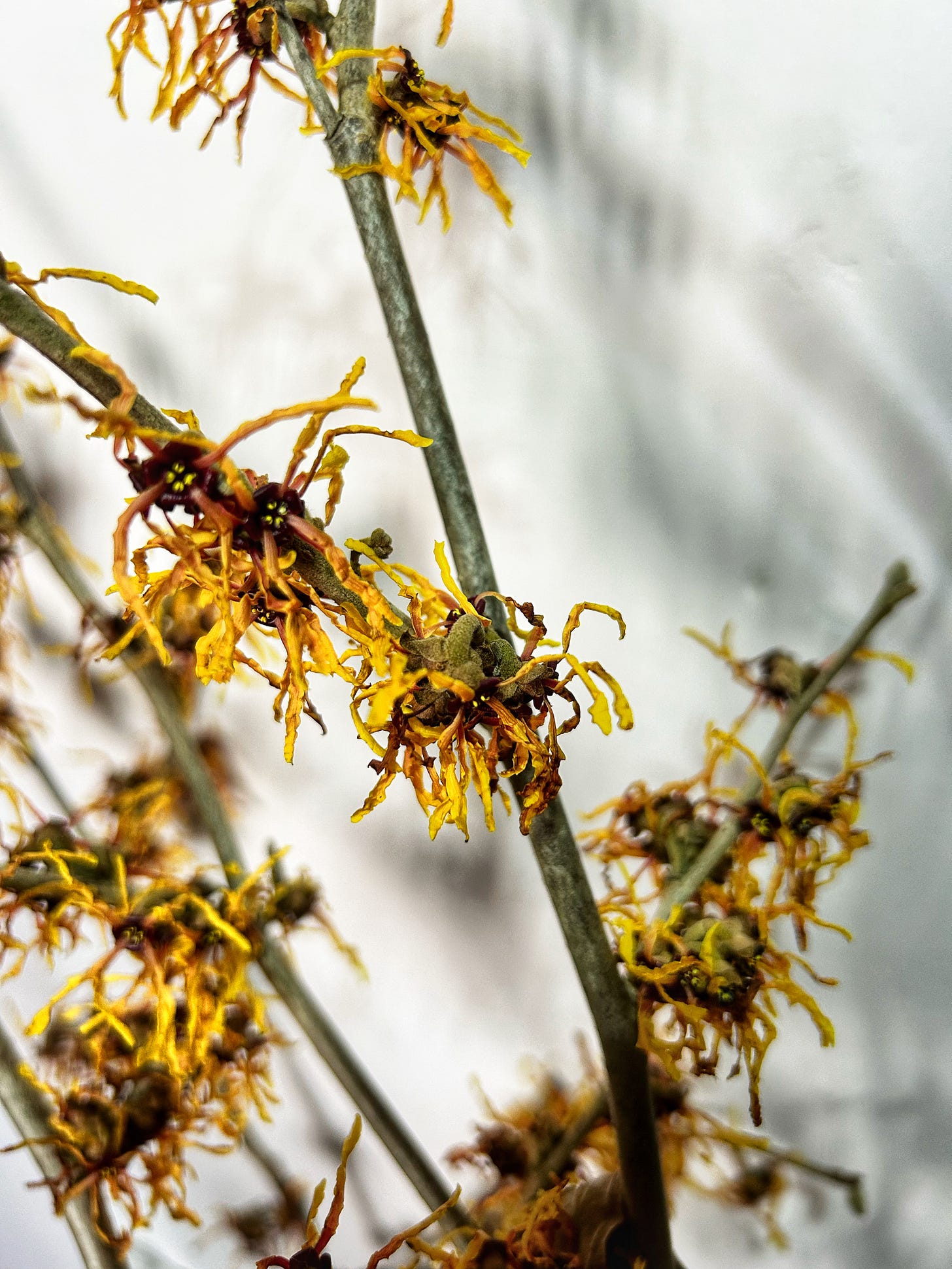Welcome to Regen Notes as we move into 2025.
Regen/ Notes is a reader-supported publication, so a big thank you and welcome to new subscribers. To receive new posts and support my work, please do consider becoming a paid subscriber.
Calendar Plants
Inspired by the reading of The Serviceberry, where Robin Wall Kimmerer references the Serviceberry as a calendar plant, I have been reflecting over the winter break on what are (my) UK calendar plants. Those that enable us to connect with and understand the seasonal changes through plants around us.
What can calendar plants teach us as individuals, what are the biomimicry aspects for organisations, and from a soul-centred perspective, what are the deeper, cultural and ecological lessons they teach?
Imagine, not just observing nature, but becoming a participant in its ongoing conversation. These native plants are not only botanical specimens, but living calendars, as timekeepers, they have a rhythm with the earth’s seasons, inviting us to connect.
Our modern lives have become increasingly disconnected from natural cycles. We live in climate-controlled spaces, eat food shipped from thousands of miles away, and often experience seasons through digital screens rather than full sensory immersion. Yet, our biophilic self, our bodies and our cellular memories, still remember an older way of being - a way intimately synchronized with the natural world.
Each calendar plant can be an invitation to be present. By paying attention to these plants, we’re practising a form of ecological mindfulness that goes beyond individual wellness. We become both witnesses and participants in a much larger ecological story. We start to feel what it means to be connected, in kinship.
This is not romantic naturalism, but a pragmatic, embodied kinship. It’s about understanding that our well-being is fundamentally linked to the well-being of the ecosystems we inhabit. When we know the rowan’s flowering signals a particular insect emergence, when we understand the sloe’s ripening indicates a specific bird migration - we’re developing an intimate literacy with the living world.
Seasonal connections are also about reciprocity - understanding that we are not separate from nature, but a living part of a complex web. When we mark the blackberry’s ripening not just as a visual event, but as an invitation to gather, to preserve, to share - we reconnect with ancient practices of sustenance and community.
Seasons turning now Nature’s rhythms guide our mind Wake live reap rest
So here is a kind of personal almanac, my almanac, but also an organisational almanac, that can and will be returned to throughout the year.
January
A wonderful Christmas gift of a witch hazel plant inspired me to place ki as the January calendar plant. Yet although the Witch Hazel has become deeply integrated into British winter garden culture since introduction in the 18th century, particularly due to flowering in the depths of winter, it is not native to the UK.
During the Arts & Crafts garden movement (1880s-1920s), Gertrude Jekyll known for companion planting wisdom was particularly favored witch hazel. She wrote in “Wood and Garden” (1899): “The witch hazels bloom and give off their sweet and powerful scent, carrying the promise of spring even in the darkest days” championing the planting of witch hazel against dark evergreen backgrounds to highlight the yellow blooms.
So it is the common and winter hazel, (which we have a number of, ready for coppicing in our garden), that I have chosen to start the calendar plant almanac.
Hazel (Corylus avellana)
The hazel’s golden catkins are the harbingers of new life, hanging like wind chimes against a winter landscape. Though its nuts won’t mature until autumn, its early flowering speaks of resilience.
The hazel blooms in threads of crimson hue
Peep through the swelling buds foretelling Spring
John Clare: First Sight of SpringIn Celtic mythology, hazel is considered a tree of wisdom and poetic inspiration. The nuts are believed to contain great knowledge, with salmon in sacred rivers said to grow wise by eating fallen hazelnuts. Druids associate the tree with learning and meditation. Traditionally, hazel rods were used for divining water and finding lost objects, a practice called dowsing that continued well into the 19th century and may be seeing a revival.
The hazel’s golden catkins are not just a botanical event but a meditation on resilience - teaching us that life persists and renews even in the most challenging conditions. When we pause to observe its delicate flowering, we’re not just seeing a plant but experiencing a profound lesson in patience and potential.
The Hazel invites us to embrace dormancy and potential, limit external commitments, focus on internal planning and reflection, and find the time and space to allow natural regenerative cycles.
Into 2025
February: Blackthorn (Prunus spinosa)Before its leaves emerge, the blackthorn bursts into clouds of pristine white blossoms. These delicate flowers are a stark contrast to the plant’s formidable, thorny branches. These early blooms are critical for early pollinators and hint at the sloe berries that will develop later in the year.
March: Primrose (Primula vulgaris). While not a fruiting plant in the traditional sense, the primrose is a quintessential native wildflower that marks the true awakening of spring. Its pale yellow flowers carpet woodland edges and hedgerows, symbolizing the gentle return of warmth and light.
April: Wood Anemone (Anemone nemorosa). These lovely white flowers carpet woodland floors before tree canopies are in full leaf. They’re not fruit-bearing plants, but they’re a critical indicator of ancient woodland ecosystems, creating an ethereal white carpet that speaks of spring’s tender beginnings.
May: Rowan (Sorbus aucuparia). The rowan begins to show its promise in May, with clusters of white flowers that will later transform into vibrant ki red berries. Native to the UK, it’s steeped in folklore and critical for wildlife, with its berries feeding birds in autumn.
June: Wild Strawberry (Fragaria vesca). Now we enter fruiting seasons! Wild strawberries begin ripening, tiny jewels of sweetness hidden in woodland clearings and hedge bottoms. Though small, they’re intensely flavoured and a crucial food source for woodland creatures.
July: Raspberry (Rubus idaeus). Native wild raspberries start ripening, their red fruits lighting up woodland edges and clearings. Unlike cultivated varieties, these are smaller but more intensely flavoured, a true taste of the British summer.
August: Blackberry (Rubus fruticosus). The quintessential British summer fruit begins to ripen, transforming hedgerows into abundant larders. Native and widespread, blackberries are a cultural touchstone of late summer foraging.
September: Rowan Berries (Sorbus aucuparia). The rowan’s berries reach full colour, transforming from green to brilliant red, providing crucial food for migrating birds. They symbolize the transition from summer to autumn.
October: Hawthorn (Crataegus monogyna). The hawthorn's red haws become prominent, decorating hedgerows with clusters of bright berries. These fruits are vital for winter bird populations and mark the deep transition into autumn.
November: Sloe (Prunus spinosa). The sloe berries, born on the blackthorn’s thorny branches, reach their peak. Traditionally used for sloe gin, these dark blue-black fruits represent the harshness and beauty of the approaching winter.
December: Holly (Ilex aquifolium). With its bright red berries against dark green leaves, the holly represents midwinter. Native to the UK, it’s not just a Christmas decoration but a critical winter food source for birds and a symbol of endurance.
Reflection - on a Living Blueprint
Imagine a planning approach that doesn’t just observe nature, but learns to think like an ecosystem. Just as the rowan tree survives on windswept mountainsides, bending without breaking, we must develop planning strategies that are fundamentally alive - responsive, interconnected, and inherently adaptive.
Nature has been solving complex survival challenges for billions of years. The woodland floor is not a static landscape, but a dynamic conversation - mycorrhizal networks sharing information, plants communicating chemical warnings, organisms constantly negotiating survival through collaboration and rapid adaptation.
Our current planning models are mechanical - rigid structures that assume predictability in an inherently unpredictable world. But a forest doesn’t plan. It responds. It learns. It transforms.
Consider the resilience of a mature ecosystem. When disturbance occurs - a forest fire, a landslide - the system doesn’t collapse. It reconfigures. Certain species die back, while others emerge. Information is stored in seeds, in root systems, and in the genetic memory of survival. Each disruption becomes an opportunity for transformation.
This is biomimicry planning: viewing human systems as living, breathing networks rather than machine-like structures. We’re not designing for a predicted future, but cultivating capacities for whatever future might emerge. Just as a mature ecosystem holds multiple potential successional states within its living architecture, our human systems must become platforms of possibility.
This isn’t just ecological philosophy. It’s a radical and necessary reimagining of how we understand survival, adaptation and collective intelligence.
From Fairsnape RegenCards
“The more clearly we can focus our attention on the wonders and realities of the universe about us, the less taste we shall have for destruction.” - Rachel Carson
Self “Where do you find sanctuary in the natural world?” Reflecting: “How has your relationship with place evolved over time?” Doing “What patterns of regeneration can you observe and apply in your current work?” WildCard ""WHOLENESS: How does this particular moment connect to the larger story of life?"





